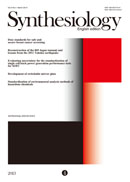Volume 5, Issue 4
Displaying 1-9 of 9 articles from this issue
- |<
- <
- 1
- >
- >|
Research papers
-
2013Volume 5Issue 4 Pages 228-240
Published: 2013
Released on J-STAGE: April 03, 2013
Download PDF (2073K) -
2013Volume 5Issue 4 Pages 241-250
Published: 2013
Released on J-STAGE: April 03, 2013
Download PDF (10469K) -
2013Volume 5Issue 4 Pages 251-261
Published: 2013
Released on J-STAGE: April 03, 2013
Download PDF (1534K) -
2013Volume 5Issue 4 Pages 262-269
Published: 2013
Released on J-STAGE: April 03, 2013
Download PDF (1836K) -
2013Volume 5Issue 4 Pages 270-286
Published: 2013
Released on J-STAGE: April 03, 2013
Download PDF (1731K)
Editorial board
-
2013Volume 5Issue 4 Pages 287-288
Published: 2013
Released on J-STAGE: April 03, 2013
Download PDF (247K) -
2013Volume 5Issue 4 Pages 289-290
Published: 2013
Released on J-STAGE: April 03, 2013
Download PDF (252K) -
2013Volume 5Issue 4 Pages 291-292
Published: 2013
Released on J-STAGE: April 03, 2013
Download PDF (215K)
Letter from the editor
-
2013Volume 5Issue 4 Pages 293
Published: 2013
Released on J-STAGE: April 03, 2013
Download PDF (239K)
- |<
- <
- 1
- >
- >|
